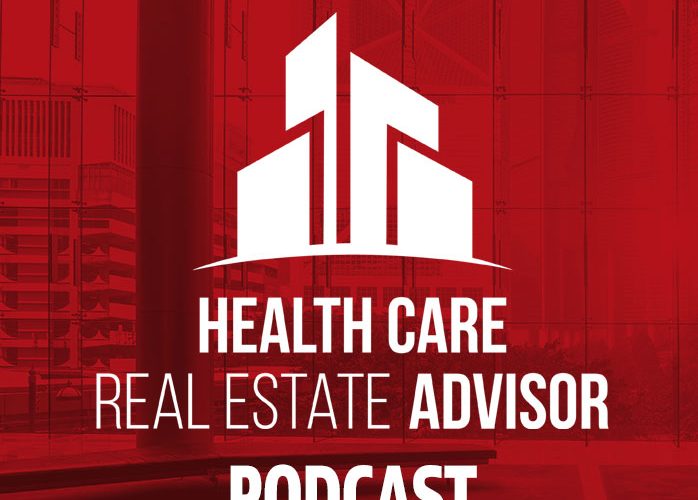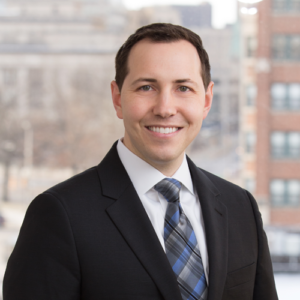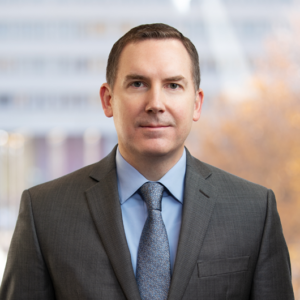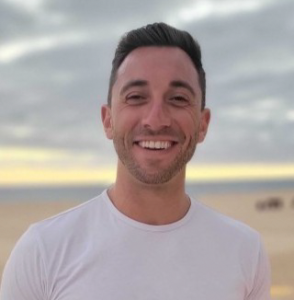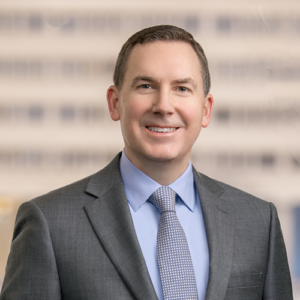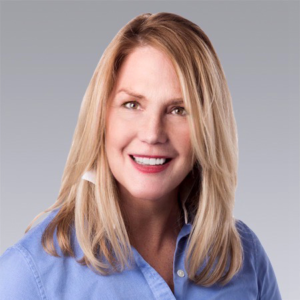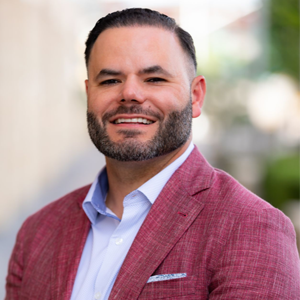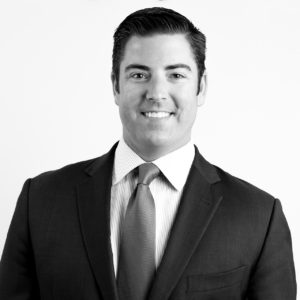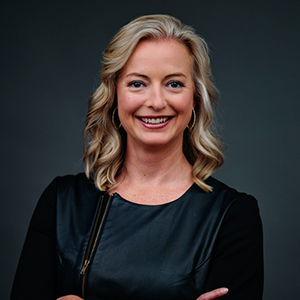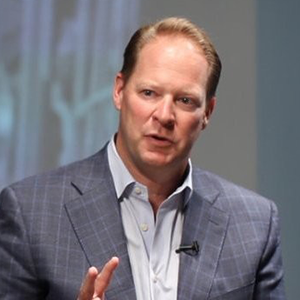Mid-Year Checkup: Navigating 2024’s Health Care Real Estate Trends
Mid-Year Checkup: Navigating 2024’s Health Care Real Estate Trends
As we reach the midpoint of 2024, it’s time to assess the health care real estate landscape. Did the bold predictions from analysts, brokers and other experts come to fruition? Are the trends aligning with the forecasts, or is it too soon to tell?
Join us for an insightful discussion as Hall Render’s experienced attorneys provide a comprehensive mid-year roundup of health care real estate trends.
Podcast Participants

Addison Bradford
Hall Render Attorney

Danielle Bergner
Hall Render Attorney
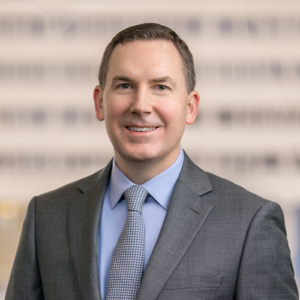
Andrew Dick
Hall Render Attorney

Libby Park
Hall Render Attorney

Joel Swider
Hall Render Attorney
Joel Swider: Thanks everybody for tuning in today. I’m Joel Swider with Hall Render, and I’m joined by several of my Hall Render colleagues, including Danielle Bergner, in our Milwaukee office, Libby Park, in our Denver office, Addison Bradford in our Indianapolis office, and Andrew Dick also here in Indy.
So at the beginning of each calendar year we often see brokers, advisors, and other commentators making predictions on what they view will be the top trends for the year in Health Care Real Estate, and, in fact, this year Hall render published our own predictions for 2024.
But now that we’re halfway through the year, we thought it would be interesting to revisit some of those predictions, see which ones have actually materialized and kind of talk through where things might be going. In the second half of the year.
By the way, if anyone listening does have comments or wants to share some other viewpoint, we’d love to hear it. So please do drop us a line with that. Let’s dive in
One of the predictions that we made in Hall render’s 24 forecast was that capital markets might improve slightly, but would mostly kind of continue to move sideways, and we saw a few articles at the end of 23, with the mantra stay alive till 25, essentially saying that 2024 is going to be another slow year in commercial real estate, driven particularly by high interest rates, at least in comparison with the recent past, and banks that are generally less willing to lend for investment properties, at least in the short term.
So on that point, Danielle. Maybe we’ll start with you. I know you do a lot of work on projects that involve health care. Real estate finance. Has this prediction been accurate so far. And where do you see things moving the rest of the year.
Danielle Bergner: Thanks, Joel. Yes, I think it has been accurate. I think the exciting part is really yet to come, and that’s going to come later this year early next, I think that you know, for commercial real estate markets, the bottom is probably pretty near which I actually don’t think is a bad thing. You mentioned stay alive till 25, the more cynical commentators would call that extend and pretend. So what’s been going on the last couple of years with interest rates in particular, you know, remaining pretty stubborn.
A lot of commercial real estate debt that has otherwise come due has been extended. It’s been incapable of being refinanced. Negative returns are persisting. And so what we’re seeing now in the 1st half of 24 are the numbers that are proving that out. And so, you know, we’re still seeing commercial deal volume significantly down in the aggregate. But in the 1st quarter of this year debt actually increased significantly, and you might scratch your head about that. But if you think about it.
It’s because all of the debt that should have matured, you know, in 23 or even 22, is just still sitting there on the books. And so we have this kind of interesting environment where debt is still increasing. Deal flow is down. And this year we have. You know, the big balloon issue. All of this debt at some point is going to come due. And so for some people, for some investors and owners. This is bad news for Banks. This might be bad news but for others, I would say, with capital waiting on the sidelines this might be the opportunity that they’ve been waiting for to capture that upside. I think the big question in terms of predicting just how painful the next year will be, particularly for banks and for pre pandemic investors is, of course, interest rates. Some investors believe we’ll see a rate cut in September which could be the Fed’s final policy decision ahead of the Presidential election in November. And to that I would say we didn’t really need another wildcard on interest rates. But the Presidential election is definitely throwing one. Markets are already assessing the impact of candidate economic policies and cautioning the investment community that they may have to be pricing in a considerable risk of higher inflation. If some of those policies were to be implemented, which could also mean that any reduction in interest rates we see in September could be quite fleeting.
What I’m keeping an eye on is whether we’re going to see a flood of refinance transactions in the 4th quarter of this year, and 1st quarter of next for borrowers and for Banks, who want to capitalize on whatever small interest rate relief we might see out of September.
Joel Swider: Yeah, Danielle, you mentioned, you know, potential interest rate cuts inflation. Andrew or others. I mean, I know you also have been active in this space. What are some of the pressures that health providers are facing right now in trying to finance these new projects? Is it really just the uncertainty that’s kept a lot of people on the sidelines.
Andrew Dick: Sure. Yeah, I I think some of it is the uncertainty. I think. It’s also really hard to source debt right now. And I know Danielle and I were talking about this a few weeks ago, specifically, in certain sectors of the health care real estate industry. We’ll talk about that here a little later today. But what Danielle and I were talking about was trying to source debt for new senior housing communities can be particularly challenging right now. If you don’t have just the right set of facts for the lenders to to review and to underwrite.
So I think it’s really subsector specific. But it is challenging, I would say, across the board based on those that we’re talking with, with health systems, developers and those who place debt. They’re all kind of telling the same story.
Addison Bradford: And I would just add, in my anecdotal experience. You all commented on a lot of the business terms, I think, on the legal terms. We’ve seen even more constriction by lenders to be more or to be more risk adverse, such that, you know deal terms or legal terms that may have worked 10 years ago for ground lease deal, for example, just aren’t working for lenders now. So trying to bridge that gap between lenders and providers is is a challenge at the moment.
Joel Swider: So another prediction that we had made for 24, and others. I think VMG had echoed. This as well, was the continued growth of the ASC sector as well as the behavioral health sector and the specialty hospital sector. I think we started seeing this trend in 2023. And so the prediction was that this trend would continue. Libby, maybe we start with you. I know you’ve done work in all of these spaces, specialty hospitals, behavioral health, and ASCs.
What have you seen of that trend so far this year? Maybe start with ASCs, but where are you seeing that trend?
Libby Park: Thanks, Joel. Yes, I. We have been seeing this continued trend of growth within the ASC sector, and the prediction has remained on point thus far, even amidst the financing challenges that the panelists just highlighted. In the 1st question that you raised Joel, there are a couple of unique factors within the ASC sector that contribute to its continued growth throughout the 1st half of 2024, and it’s expected to continue throughout the remainder of 2024 and onward primarily 2 reasons, the 1st being changes to state certificate of need laws, and the second being technological advancement within the ASC space. On the 1st point we’ve seen a loosening and even repealing of certificate of need laws in multiple states across the Us. And Com. Laws have historically been a major barrier to entry for ASCs. Coming into this space in, for example, the last year or so, South Carolina, Tennessee, Mississippi, and a few other States have largely rolled back their com requirements and a couple of points as state specific. What we’ve seen in connection with these rollbacks in both South Carolina and Tennessee, while there have been repeals and rollbacks of certificate of need requirements, those come with additional State licensing requirements and also requirements to provide that new ASCs provide indigent care or charity care to a certain amount of the population. State specific requirements vary, based on the amount of charity care that certain ASCs must provide, and South Carolina’s, for example, is a percentage of the ASCs. Adjusted gross revenue after 2 years.
Additionally, we’ve seen the State of Mississippi make certain revisions to their health plan, whereby hospitals can become more involved in in the ASC. Space.
In other States, including Georgia and Iowa, are also undergoing certain review and reform of their laws which it’s yet to be seen exactly how the legislature will move on that issue. A second critical factor that’s affecting ASC growth is technology. We’ve seen a real breadth of technological advancements within the ASC space complemented by payers being willing to fund these types of technological advancements. Certain technologies that we’ve seen are robotics to help surgeons perform less invasive procedures, software platforms related to EMR management solutions, scheduling business analytics, AI to support data processing patient wearable devices. And really, the data that we’re seeing is that technology is providing for better health care outcomes and insurers are willing to pay for it. So we think that will continue the growth trend as well.
Joel Swider: Thanks, Libby. Addison, I know you’ve done a lot in the behavioral health space. Where do you see us headed the remainder of the year?
Addison Bradford: Yeah, I think the trend will continue and that there will be increased investment and construction behavioral health facilities.
I think the free reason for that is first, I think the demand still there. I don’t think the supply is caught up with the demand when it comes to behavioral health services around the country. There are still lots of communities throughout the Us.
Where there are behavioral deserts or there just aren’t viable options for most people. So until that kind of supply demand curve levels out, I think we’re going to see you know, more investment in this space. And these projects are going to continue to be possible to because of the State and Federal grant funding that at least I’ve seen specific to behavioral health facilities.
Last month I saw that the State of Texas was investing 1.5 billion dollars in 7 behavioral health facilities, some of which were new build, some of which were rehab but just a huge monetary investment to make those projects viable, and I mean on smaller scales like I saw in last week this State of Washington was investing 7.5 million a lot less than 1.5 billion. But still, you know, significant amount of money in, I think, 5 or 6 of their existing facilities. To make sure that they continue to operate and don’t have to close down and create more kind of behavioral health deserts for their communities. So long as we see that funding and that demand, I I don’t see it slowing down in the interim.
Joel Swider: That it raises an interesting point is there? Do you anticipate that certain States will pull ahead of others in terms of investment. I’m thinking particularly about behavioral health, but I I think there might be other sectors at play here, too, particularly as it pertains to Co. N, or on the flip side of that sort of the grant funding piece. I mean, do you think that we’re going to see significant kind of distinctions between states in that area for development.
Addison Bradford: Yeah, I mean, I think likely. I mean, there are a number of state specific regulations and licenses that can dictate. For example, I mean one of the biggest barriers to the ASC. You know, construction of Acs is Co. N laws, which let me went into. So we’re the more. We see states, you know, and it seems to be redder states at the moment that are loosening their restrictions. I think in those states you’re going to see a lot more A/C development.
But you know each stay is a little bit different. So it’s hard to see if there’s, you know, red versus blue States or East Coast versus West Coast, whether you’re going to see more investment. But certainly state policies can affect the amount of development we’re going to see in different areas.
Joel Swider: So next topic, here is health care joint ventures, and health care joint ventures appeared in a number of the 2024 prediction articles. Some talked about them sort of on the fringe, or more or less in passing. Other predictions dealt with JVs more directly. Ankara, for example, had predicted that Hospital JV’s with what they called payers payer providers such as optum would really increase in 2024. Andrew, maybe we start with you. I know you’ve done a lot in the JV. Space is the prominence of health care JVs increasing, decreasing, leveling off. What do what are you seeing in this space?
Andrew Dick: Yeah, I we don’t have a lot of good data on joint ventures, and the term joint venture can mean a lot of different things to different providers. So when we talk about joint ventures, we often think it’s a true partnership, or 2 providers come together and form a new entity, and they own, you know, they split up ownership percentages. But that’s not always the case. Sometimes it’s different providers simply collaborating together, providing different services within the same building. For example, we’re seeing a lot of those type of JV’s in the oncology space right now and it seems like a lot of the big health systems are really interested in growing oncology. JVs, right now. And those can be really complicated. But I would just point our audience to the health facilities management. They had a 2024 construction survey, where they went out to their members, and which are primarily hospitals and health systems, and they surveyed those folks to say, what do you plan on building over the next 3 years? And if you look at that report, there’s some really great information. And the top 3 or 4 types of JV facilities that that health systems are looking to build our behavioral health hospitals inpatient and outpatient, I I should say cancer centers children’s hospitals and rehab hospitals.
We’ve seen that those deals come across our desk quite a bit, and all of those categories. But I just I just think right now we’re seeing a tremendous amount of joint venture activity across the board surgery centers, behavioral health that we talked about inpatient rehab hospitals.
We’re also seeing some really interesting joint ventures between government agencies and nonprofit health care providers and for profit providers coming together trying to figure out how they can better deliver care in certain markets and I think that’s really exciting. So I think there’s a lot of activity right now. I wish I had more data on the number of joint ventures, but just kind of what I’m seeing in the market and what we’re our group is seeing. It’s just an uptick in that kind of activity where providers are looking to come together to really deliver you know better services in these specialty areas.
Joel Swider: Yeah, thanks, Andrew. And one thing returning, I I didn’t notice until just now, but we did have a couple of questions that came in on the ASC topic, which I think is is still relevant for this JV question. But couple questions related to the size of various ASCs being developed, you know. Are they on the smaller side, larger footprint? What’s been sort of the? Are there any parameters? And if so, you know, what are they? And then the second question unrelated to that. But, you know, are we seeing more affiliated hospital network type ASCs or more independent ASC growth? I’ve got some anecdotal evidence on these, but wanted to see if anybody else had had been, seeing that in this space recently.
Libby Park: Hey, there, Joel, I can chime in on those first.st As to the size of ASC space, it depends. I’ve seen varied square footage depending on the location of the ASCs. The resources of the joint venture. Municipal requirements. For example, if space is limited in a highly urban populated area. I’ve seen something around, maybe 1,500 square feet to much larger ASCs in terms of square footage. If the area has the space has the demand and the geography to support it in terms of, if the ASCs we’re seeing are more hospital affiliated or independent providers, that also it depends, for example, in Mississippi the loosening of the certificate of need requirement really provided the opportunity for hospitals to get into the ASC. Space, either independently hospital operated, or connect in connection through joint ventures with physicians.
So it really is kind of a state by State analysis as to what the applicable certificate of need and State law requires, and kind of the demand and operation of ASCs is responding to each State specific law.
Joel Swider: Yeah, that’s been consistent, Libby, with what I’ve seen lately as well on both points. And in particular, I do think there’s a certain footprint that you almost need to have to make the project viable. Now, and I think to your point it probably depends on State law and a number of other factors as to where you draw that line. But I do think there may be some, and I guess it goes back to the financing question, too. Right? And then as to kind of the independent versus hospital affiliated, I’ve seen both as well and so I’m curious to see, you know, to see how that plays out.
Andrew Dick: I have one more comment on that. As I was listening to our group. Talk about challenges raising capital, you don’t, you know, for new projects. You’re not really seeing that in the ASC Space and I think it’s because they’re often a little bit smaller. Then, like a new inpatient facility in terms of you know, the price point may be somewhere between 5 and 10 million dollars, whereas a new behavioral health hospital may be 30 or 40 million dollars.
But the one thing I keep hearing from our clients is, there’s really they’re not having any challenges raising bank debt for those type of smaller ASC projects. And in some cases they’re just bringing all the equity. They’re just bringing their own capital and funding it with cash on hand. And I just find that really interesting, because we’re seeing a lot of construction activity. And it doesn’t seem like some of the challenges we talked about are popping up with new surgery centers. And my, my hunch is that it’s maybe because some of these smaller, local and regional banks are willing to make 3 or 4 million dollar loans, as opposed to, you know, coming up with 20 or 30 million dollars for a new specialty hospital.
Addison Bradford: Andrew, if I could follow up with a question to you on that. It seems like from the deals I’ve worked on, that there’s a lot of, especially with hot specialty hospitals. There’s a lot of education that has to go on with the lender as to like reimbursement. How ultimately these services are paid for. Do you think part of the kind of the more the more investment is ASC a product of just more lender understanding of that that market.
Andrew Dick: You know. That’s an interesting point, Addison. You could be spot on. It may be that that surgery centers have been around long enough, and they’re well, no more. Well known by the lay, you know, underwriter who’s working on these deals. I think. Yeah, that could be the case. I also think it’s just a smaller capital outlay for these banks and they just think, gosh! If I have a health system, and 20 different physicians investing in the surgery center. That seems like a sure bet is is, I think, what’s going on again. I think it’s it could be geography specific.
Joel Swider: So let’s dive into that a little further, because that was another prediction at the start of 24. With respect to capital projects and construction. At the beginning of the year both S & P and Price Waterhouse, PWC. They were essentially, I’ll say, cautiously optimistic. And S. And P. Had said that health providers would likely restart their deferred capital projects. They couldn’t put them off any longer, and would maybe start relying more on debt to support these projects than they have in the recent past PWC noted that private equity firms had a lot of capital on the sidelines, and would essentially be looking for opportunities to invest in 24, and that that might drive new development.
Maybe question for you, Danielle. What have you seen of these predictions? Have they been borne out so far in 24? And what do you see on the horizon in terms of these larger capital projects?
Danielle Bergner: Well, I think capital projects are, you know, largely this year moving forward, but much slower than people would like. I think many are. Still seeing significant delays due to the same combination of challenges that we’ve seen for the last 3, 4 years. Inflationary pressures supply, chain, skill, labor, shortage. But I would say, on the whole, we are seeing more construction, activity, moving forward. The key right now, I really think, is creativity. You know, the traditional health care finance box of using bond proceeds, or cash even to finance capital projects really just isn’t working right now for a variety of reasons, one of which includes the CFOs desire to preserve the balance sheet right which ties into credit rating.
So when you think about creativity, I think you know, like Andrew mentioned hospitals are increasingly looking at JV structures in particular, to capitalize on those private equity dollars. It definitely helps to solve a a significant portion of that of that gap in the budget or another example would be the charitable foundation lease, financing structure which allows hospitals nonprofit hospitals and health systems to finance projects without taking on the debt themselves. And so you know, what I would say is as recently as even a couple of years ago, I would say we weren’t seeing CFOs and project managers and executives as willing to look at financing structures outside the box, and now they are hungry for it. They are wanting to see all of the options, put it all on the table, and figure out how to get some of these projects moving forward. The demand is still there. The challenge is, you know, how to put the capital stack together.
Joel Swider: Thanks, Danielle, so I think this kind of leads us into the next prediction, which was at the end of 23, heading into 24 there were, I guess I’ll call it more of an outlook, because 2 of the 3 major credit rating agencies had issued a negative outlook for, and this was for the nonprofit acute Care hospital sector in 24 S. And P. Had issued a negative outlook, saying that
they saw health care demand remaining strong, but it was going to be weighed down by persistently high labor, persistently high operating costs, and essentially the payer mix would also weigh down the sector. They even said that they could foresee additional downgrades into the future. Fitch. The term they used was that the sector would remain deteriorating in 24, but they said, You know, we’re going to start to see some stratification that hospitals that could attract and retain employed staff rather than having to rely on external contract labor, which is typically more expensive, that those hospitals would be able to recover their deficits much faster. Moody’s was the only one of the 3 that revised its outlook from negative to stable, going into 24, and Moody’s predicted some modest volume increases, but they were expecting that negotiated reimbursement rates would increase and help the cash flow. Margins, I guess, Danielle, you know, continuing on in this vein, as you’ve observed the sector thus far in 24, and I guess particularly the inpatient hospital sector. But I think it’s broader than that. Who’s right? Is it negative? Is it deteriorating? Is it stable? And how does this play into some of the other developments and the creativity that you just touched on.
Danielle Bergner: So, in terms of the agency ratings, I would say that their forecast for this year, are playing out with some fair accuracy. What I’m a little concerned about is the bifurcation of financial recovery that we’re seeing between nonprofit hospitals and systems. What we’re seeing is like, you know, like the agencies predicted, those that could most successfully contain costs would recover more quickly. We’re seeing that the issue, in my view, is those hospitals and systems tend to be the most diversified and well-resourced systems.
In other words, the systems and hospitals, with the greatest level of resources, have been able to rebound on their margins similar to those pre pandemic. But the more modestly resourced hospitals and systems appear to be recovering at a much slower pace. So far this year many ratings have remained more or less unchanged. But 15 have been upgraded and over 30 have been downgraded this year already. Now the silver lining, if there is one, is that by this time last year nearly 60 had been downgraded, which at least suggests some level of sector level financial recovery, albeit extremely slow. So I think you know the agency’s references to persistent challenges. I think that’s exactly right. Of the 15 upgrades. The commentary indicates some mix of improved liquidity, notable improvements, and operating margin healthy payer. Mix other interesting factors that are kind of trending out of the out of the agency ratings is location. The higher growth markets, like Florida or Texas are realizing financial recovery at a much higher rate and more favorable state driven Medicaid payment programs also appear to be in impacting the bottom line in a material way. And then, of course, mergers are definitely, you know, impacting these outcomes going forward. I’ll just leave you with this nugget to think about. But going forward, I think we also have to keep our eye on technology, especially AI, and it’s potential to put even greater distance between nonprofit providers in terms of financial performance. Those that this technology is very expensive. So those hospitals and those systems that can afford to purchase this technology will be able to capitalize on it and those that cannot afford it will not be able to access the full potential of these tools potentially, you know, further, even expanding that divide between, you know the more resource and more modestly resourced hospitals and systems. So it’s not an issue that is being talked about expressly as of yet in rating agencies. But at some point I have to believe that technology is going to start moving the needle on the bottom line for a lot of our clients.
Joel Swider: Yeah, great point. And I know, Libby, you had mentioned that, too, in terms of the ASC sector. Let’s talk a little bit about the kind of some of the pressures that we’re seeing in the sector. So at the outset of 24 there were a number of experts that forecasted a continued struggle to recruit and retain a talented labor force, and that that would be one of, if not the greatest drags on health care performance across a number of sectors, inpatient, acute care, senior living home health. Addison. Maybe we start with you on this. I mean, where are we seeing the health care labor market go, has it leveled off this year?
Addison Bradford: Yeah? I asked. As many of you know, my wife works in nurse recruiting. I asked her this last night, and she just said, no that was it, and I think she’s right, and I’m not just saying that because she’s my wife, and she’s right about everything. But I think, more generally. I mean we we see it all over the place. We see, continued Burnout, among providers, that may, or that has continued since Covid. Now I think some of the burnout isn’t necessarily related to Covid, and it’s more related to staffing levels that are in turn affected by Covid. But you know you’re seeing I feel like strikes in in the news every other week or every week. With nurses and other providers striking because of staffing levels within their hospital systems. And you know, it’s interesting. I’ve also seen an uptick, at least in in the state of Indiana, with an increase in lawsuits, negligence, wrongful death, other types of lawsuits that arise from the failure to staff hospitals and other health care facilities at a certain level. So I don’t think in any way we’re out of the woods yet, and it’s been interesting. I know Libby and I were talking before this, that there’s been, you know, on the senior level side there’s intended there’s been some intent to try to fix some of those staffing issues, Libby. I don’t know if you can speak more to that.
Libby Park: Yeah, absolutely. I can. Thanks Addison. First, though, I second, that your wife is wonderful and incredibly intelligent. Great on the legal front of these types of staffing challenges. CMS. Has absolutely kept a pulse on what’s been going on, and as it relates to the long term care front. I wanted to flag to our attendees that CMS. Published a rule May 10th of this year, that is, was effective just last month, June 21, 2024. Regarding minimum staffing standards for long term care facilities and Medicaid institutional payment. Transparency reporting final rule. That is a mouthful. But in short, the rule requires minimum staffing standards in nursing homes and long term care facilities. The commentary that was included in the Federal Register relating to this Federal rule really echoed what Addison discussed, that
there are staffing shortages which result in or quality of care, staff, burnout, high turnover, which implicates the health outcomes of these types of facilities, and CMS’s goal in promulgating this rule was to hold nursing homes accountable for providing safe and high quality care for nearly 1.2 million residents that are in these Medicare and Medicaid certified long-term care facilities. A few of the key requirements that are included in the rule are an increase in registered nurse staffing requirements. This will require an Rn. To be on site 24 HA day, 7 days a week, with certain limited exceptions, as well as an increase in the hours per day of resident care, which is a combination of direct Rn. Care as well as direct nurses aid care, and the new requirement is 3.4 h per resident day. There are different time frames for implementation of the requirements set forth in the rule depending on geographic locations up to 5 years for rural facilities up to 3 years. For non rural facilities. However, all facilities need to take steps to implement a facility assessment update a general plan which most facilities already have by August 8th of this year. So CMS. Did roll out some aggressive timelines. But the initial deadlines should not be hopefully a large lift for these facilities.
Folks should know that there are also certain exemptions, exemptions in limited circumstances where a workforce may be unavailable, or if a facility is making a good faith effort to hire staff, but just cannot locate them. Other documentation requirements are also needed for the hardship, exemption, but they are available in limited circumstances in terms of estimated cost. Associated with these requirements for increased staffing. CMS. Estimates that approximately 53 million nationally will be needed in year one for implementation, with an escalation of up to 43 billion in year 10, and CMS. Acknowledged in its rule that there is uncertainties about how facilities will bear the cost of meeting these types of requirements, and they suggested a three-pronged approach that either the facilities one reduce their margin or profit to reduce other operational costs, or 3 increase prices charged to payers. So the prediction is that the costs will likely be shared between the facility operations as well as payers. On a final note, CMS. Did also announce that it is launching a new investment campaign of over 75 million 75 million dollars to launch a national nursing, home staffing campaign. And the goal here is really to incentivize nurses to work and nurses aid in the nursing home environment. Things like tuition, reimbursement, enrollment training, finding placements with job services are a few things that are included in CMS’s proposed funding for to support the staffing initiative.
Addison Bradford: Thanks, Libby, that’s helpful. If I could just add 2 more points on. This is, you know. I I think, in terms of looking forward further. I mean the turnover rate. I might think of my nurses last year improved like 2 and I. You know I would wouldn’t be shocked if it was 2 this year, and I think really, until we see a you know more supply of physicians and other providers, I mean, the met school classes are increasing, but they’re increasing very marginally, and our immigration system isn’t going to be reformed. It seems like anytime soon to allow more doctors from outside the country to work in our hospital. So you know, until again that supply keeps up with the May demand. I wouldn’t be surprised at this, we’re talking about the same issues next year.
Andrew Dick: Yeah, I know, I, I have one more thought. I don’t know if others have seen this. But I was listening to a podcast over the weekend that’s hosted by a Michigan hospital, CEO. And he said the State of Michigan tried to impose a similar staffing mandate on inpatient hospitals, and that bill was defeated. But I thought it was interesting that the hospitals are watching for similar legislation and the CEO and the podcast he said. You know we’re having such a trouble. Staffing our hospital, he said. If we’re forced to have minimum staffing standards that, he said, it’s probably going to force us to scale back the number of beds that we actually operate. And it was a really interesting discussion, not getting political. But if if anyone’s interested, it was on the rural health rising podcast really great, podcast hosted by a really dynamic CEO. So I thought that was interesting as well.
Joel Swider: Yeah, Andrew, that’s a great point. I’m Olivia. And you said CMS’s response to, you know, providers who were worried about the cost of these minimum staffing standards. CMS’s response was to reduce their profit. Margins. Right? But it’s like, you know, the Andrew, I think you know a lot of people have decried the sort of stratification in health care where you see some of the more wealthy areas getting the higher acuity and more specialty care while some of the more rural or lower population areas are forced to cut back. And you know, I think there’s an economic reality there. As much as you know, CMS or other regulators would love for everything to to be equal and to have you know, as much staffing as possible. It’s just, you know, not economically feasible in certain communities. And so I think there has to be some consideration for that, my personal view. But let’s talk a little bit about senior living and long term care going into 2024. The deal volume was down, and experts had attributed this to high interest rates, higher cap rates, slower recoveries and occupancy, and generally, like we’ve talked about increased operating costs primarily due to the labor market.
There were several sources that released their own senior living outlooks for 24, and those were mixed. Hilltop had said that the sector would probably move more or less sideways in 24 jll. Had anticipated that occupancy would continue to recover, particularly as the over 75 population grows and the Argentine forecast said that the Western and Southern US would see the most recovery while labor would remain a challenge across the country. Andrew, maybe we stick with you on this question, as you’ve observed, the senior living market so far this year. Who was right, and where are the growth opportunities for the remainder of the year?
Andrew Dick: Yeah, it’s interesting, Joel. I’ll break down this sector in 2 different parts when we tend to talk about senior living. Sometimes you can that includes assisted, living, independent living, and then sometimes skilled nursing is included, that in that industry as well. But I really group assisted living and independent living together and then treat skilled nursing a little differently. We saw a lot of transaction volume in the 1st quarter of this year in the skilled nursing industry. I think, Joel, we featured in one of our updates one of the M. And a reports that covered the skilled nursing industry, and there was a huge spike in transaction volume in the 1st quarter. That that I don’t think anyone was expecting but based on all the data we’ve looked at. That transaction volume was driven by financial distress and skilled nursing industry where some of these smaller skilled nursing communities, or even some of the regional players who were under tremendous financial pressure were either forced to sell or merge with a stronger operator. And so I thought that was an interesting data point that I, personally wasn’t expecting. In the 1st quarter in the assisted living and independent living sector. I think certainly, construction, new construction is way down transaction volume, I would say, is down as well. What we’re really seeing is a repositioning of assets that were built maybe 4 or 5 6 years ago. It seems like what I’m hearing in a number of markets is that there was too much construction, too many beds and some of the operators are really struggling. And so they’re trying to reposition those assets by bringing in new operators or managers to see if they can write the ship and if they can’t they’re going to have to look for an exit strategy. Because, as others talked about on this webinar. Some of their mortgage debt is coming due. It’s maturing, and they’re under tremendous pressure to try to figure out how they can either increase occupancy or increase rent, and that’s really hard in the assisted living and independent living sector from what I’m hearing, and so I’m working with one operator right now who’s going in and helping a number of those underperforming communities really trying to figure out what they can do to get these communities and better financial standing in hopes that if they’re able to do that they can sell them maybe over the next 12 to 24 months. But again, what I’m hearing is, it’s really, really challenging. Right now, it’s hard to refinance the debt that was initially negotiated for some of these communities 5 6 years ago. It’s tough right now. At least that’s what I’m hearing. I’m curious. If others have I’ve heard the same thing, but that’s again of what I’m hearing from folks I’m working with.
Danielle Bergner: Andrew. That’s very consistent with what I’m seeing, too, with clients, and just in the market generally, I think the nonprofit operators of independent and assisted living are still able to access. You know, capital resources like HUD financing and tax exempt bond financing, and they’re still able to pencil out new construction or project rehabs. Whatever the case may be, the for profit developers and operators are really struggling. They’re, you know their capital options are extremely limited. I’m seeing very little bank capital with much of an appetite for senior living generally right now. So unless you’re willing to, you know, to access HUD the HUD, you know the HUD financing, which many are not willing to go down that road. I think it’s very difficult right now for anyone other than nonprofit operators to build new.
Andrew Dick: Good points. Danielle.
Joel Swider: Daniel, we had a question that came in, or for really for anybody a moment ago, and since you mentioned that dichotomy between the for profit and the nonprofit operating partners in in these JVs. The question is, you know, we’re seeing. So this this person wrote in saying that you know they’re seeing. An impediment in securing capital for new joint venture assets like behavioral health and erfs, as some JV operating partners are promoting lease guarantee burn offs based on operating profit, and you know the question is, do we foresee a change in this? Or do we? Do we think that nonprofit health system partners understand this additional cost that they’re being burdened with. I don’t know if anybody had thoughts on that, and I think it’s broader than just one particular sector. Any thoughts on kind of these lease guarantees, and the dichotomy between the nonprofit and for-profit partners.
Danielle Bergner: I’ll start, I’m sure Andrew has some thoughts on this, too. He and I had a lot of conversations about these JV guarantees. I would say, this topic is always difficult, and I I have not worked on a health system. JV. Deal where this has not been one of the short list of major business issues. And you know a couple of things that that we think about from the hospitals. Perspective is one is the guarantee pro rata. So are you guaranteeing the entire lease obligation, or just a pro rata share in relation to your JV. Partnership. That’s something we always consider, and then the burn off. I view that more as a business issue with the landlord and my argument with the landlord on that is typically, listen. You effectively have a credit tenant here. And when you know when you see X number of years of operating success, I do think it’s reasonable frankly, for the landlord to entertain burn offs. I don’t think that that’s an unreasonable request in today’s market. I would say we get burn offs more often than not getting them so I I actually don’t think that that should be maybe you’ve had a bad experience with some particularly stubborn landlords. But I haven’t. I haven’t been able to. I’ve never been able to not resolve that issue, I guess. Let me put it that way. The other point I’ll just make quickly is just always be careful about compliance issues with these JV guarantees because there are compliance considerations. And if your JV. Partners are referral sources, for example.
With respect to the portion of the obligations that you’re guaranteeing in relation to the overall benefit, so that’s always A topic for valuation as well.
Andrew Dick: I think Danielle did a great job of summarizing the kind of the issues we think about. Joel. I also think it’s educating the lenders and the investors on these deals, because we’ve seen a number of new players come into the industry who maybe aren’t as familiar with how, as Addison noted earlier even what a specialty hospital is and then understanding the business model. And from what I can tell, in many cases these joint venture specialty hospitals are quite successful financially. Once they get off the ground, which does justify a burn off of the guarantee, it’s just understanding what type of asset you’re investing in or making a loan on and that that takes some education because these are very specialized subsectors of the health care industry.
Joel Swider: Yeah. And I think, too, I mean, the one thing I would add is on the anti kickback statute piece that we often have to deal with is, you know, what’s the value of that guarantee? And making sure that it’s being taken into account in the pro forma so another prediction that all render had included in our outlook for the year was the continued increase in the tightening regulatory environment. In 2023 we had seen the FTC. Homing in on what it viewed was kind of anti-competitive M. And a activity. There were ownership, disclosure, requirements that went into play for sniffs. We talked about minimum staffing. We talked about the State Co. but the prediction, at the time at least, our prediction was that this kind of governmental oversight would continue to tighten the regulatory environment this year. You know, we had a couple comments come in as to the steward health bankruptcy, and whether that will potentially lead to future and increasing scrutiny from regulators. Addison, let’s start with you on this, as you look over the past 6 months of the year in terms of regulatory activity. What kind of a picture do you see?
Addison Bradford: A mixed back for sure. I mean you. You’re absolutely right. And you cited to the you know, some of the initiatives we’ve seen at the Federal level in terms of anti competition in terms of, you know, trying to get rid of non-competes we see certainly an increased focus on private equity and health care, both at the State level and at the Federal level.
But at the same time. You know, as Libby described earlier. There’s been loosening of State coin laws, and you know I mean, the ultimate room is, you know, the lower decision issued by the Supreme Court last month in which, you know, they essentially got rid of chevron deference. Which will, you know? We, we, you know, allow for potentially greater challenges to, you know, Federal regulations. So you know, it’s a really murky picture. Now, that’s only getting murkier because of the different. You know, the Presidential election that’s later this year in the, you know, clear difference and posture. As to the administrative state that the 2 parties are taking.
Joel Swider: Yeah. And Addison, could you? Just for those who aren’t lawyers on the on the line could you talk a little bit about the chevron deference, and what that, what the implications are, or could be for overruling that.
Addison Bradford: Yeah, no problem. So chevron deferences generally statutory interpretation to tool. So if there’s an ambiguous statute the courts are generally going to defer to a Federal role agency’s interpretation of that statute. and so what the Loper decision handed down last month said was that we’re not going to give deference to the agency interpretation, said, We’re, going to you know, look at it under our typical rules. Assess your interpretation whether it is reflective of the ultimate statue so we, you know, it’s been a month, so we don’t have a ton of litigation that’s really fleshed out on that. But again, the kind of deference that CMS and other Federal agencies have been given doesn’t exist anymore, such that there’s greater opportunity without, you know bar another legislation by Congress to challenge those rules.
Joel Swider: So in the last couple of minutes we have left here, Andrew. I know something you and I have talked a lot about is restraints on private equity, and I think it falls into this category of, you know, regulatory oversight. We’ve got at least 4 States now, with some kind of restrictions on private equity investment in health care real estate, particularly Minnesota, Connecticut, California, and Oregon and just a couple weeks ago there were 11 State AGs who signed a joint letter to the DOJ, FTC. And HHS. Basically expressing concern as to what they viewed was the adverse effect of private equity and its effect on consolidation in the health care market, I do think. And we saw a headline recently that the market is still only maybe 3.3 or something percent private equity owned. But there’s certainly been a lot of focus on this area. Could you talk a little bit about that, and how that’s either restraining or that our clients are being aware of that.
Andrew Dick: Yeah, it’s really interesting to watch the States propose legislation in this area.
Some of it is reactionary, like Massachusetts, where they have a bill that passed their State House restricting hospital sale lease backs, and it was really targeted at real Estate Investment Trust, which is awfully narrow and most of the headlines that I’ve read, and the stories I’ve read suggest that that bill was really targeted at what happened with the steward health care sale. Lease back with one of the major REITs. And I’m not sure that’s the right approach, because that seems awfully narrow.
But if you really dig deep. And if you look at what some of the State attorney generals are are really focused on, they’re worried about communities that have one hospital. I know we’re painting a broad brush by saying the regulation of private equity and health care. But what they’re really worried about are these communities that have one hospital? And if that hospital closes it could leave a community without critical health care services, and that can be devastating to a community. And so if you really dig deep. I think that’s really what’s brewing underneath here. But then some of the bills that come out cover even a broader range of health care services that could even include private equity transactions that, for example, roll up of physician practices which have a very different impact on the health care environment. That for most residents of their community. So I just think, we’re going to see more and more activity over the next 12 months, I think. Really driven by the steward. Health, bankruptcy! My hope is that things shake out with Stewart health care in a way that’s positive, and that the owners of the real estate are able to retent those hospitals. But I did talk to someone in Massachusetts a few days ago who said. You know one of their hospitals is in a in a rural community, and it’s going to be really hard to find another operator that’s willing to go in there because the margins and at that hospital weren’t very good, and so I can appreciate why, an attorney general or State legislator is trying to regulate some of the activity. I just think it needs to be thoughtful because there are some private equity providers, many in which that are, that are doing good things. We just need to make sure that we’re being thoughtful about the legislation.
Joel Swider: Well, with that we’ve reached the end of our time, thanks to everyone for tuning in today, and thanks to our panelists, a quick plug if you like this content. We have a weekly briefing that features the top 10 health care real estate stories from the week prior, and we’d love to add you to that list. So just reach out to us. We’re happy to do that.

